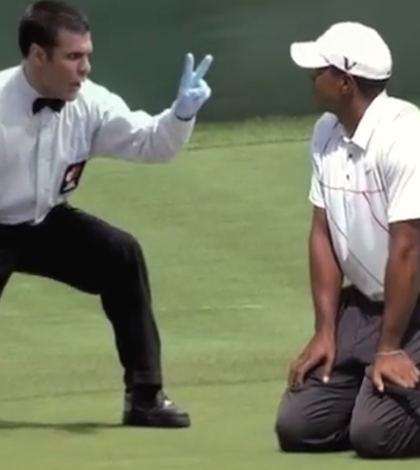Opinion & Analysis
The Sport of Golf: Nike’s newest Tiger Woods commercial

[youtube id=”oDcb3eAAK1s” width=”620″ height=”360″]
Analogy session 101. Nike is to advertising what Kafka is to text.
Artistic. Intelligent. Purposeful and evocative.
Are golfers athletes? Is golf a sport or a game of skill? A 2004 study by ESPN.com found golf to rank 51st out of 60 sports based on required components of athleticism. Incidentally, boxing ranked 1st and cheerleading lagged just behind golf. That being said, public perception is changing and Tiger Woods is as responsible as anyone. Since “Hello, world” in 1997, Tiger has changed the entire landscape of the game and the identity of a golfer as an athlete, which perhaps slow to evolve, is now undeniable.
If you think golfers aren’t athletes see: Dustin Johnson, Gary Woodland and the varied ex-MLB, NFL and NBA athletes who have reallocated their freakish athletic ability to the world’s most challenging and at times, menacing game.
Trust me, Nike gets this and its message is clear and pointed. Nike sponsors athletes. Period.
The bellowing voice announces, “On the tee, Tiger Woods.” A moment each true athlete embraces and desires. The opportunity to put on display for the masses what they have been resigned to hone and perfect in private.
Tiger emerges from the dark tunnel into the light of competition. A gladiator enters the arena, battle armor equipped. The athlete is exposed, ready to display his prowess and elite ability, a forged composite of natural gift and tireless work ethic.
Simply: It’s game time.
In this 39-second spot, Nike pairs elements of the competitive golfing experience with pieces of other sports which are undeniably and quintessentially “athletic.” The mosaic serves to remind everyone that golf, like every other sport on an elite level requires strength, coordination, speed and agility. What is left out but should be noted is that golf has mental demands which are as unique as they are intense.
The anticipation of the first tee is realized completely in the adrenaline release of a sprinter out of the blocks. The race is on and may the best man, er athlete, win.
A crucial missed putt. The champ is down (goes Frazier…down goes Frazier) but not out. The true athlete is resilient and embraces, even desires, the opportunity adversity presents. It is a chance to once again separate themselves from the masses, to exhibit the character of an athlete.
And when the crucial moment arrives — the moment that breaks some and compels others to break records — the athlete stands alone, once again exposed and ready to be defined. It is a walk-off homerun in the bottom of the 9th inning. It’s Joe Carter in 1993 and it’s Michael Jordan over Craig Ehlo in 1989. It is also equally Tiger Woods in the 2001 Players (…better than most) and the 2008 U.S. Open at Torrey Pines.
The passionate crowd reacts the only way it can: with pure and unbridled emotion, quick to celebrate and engulf the athlete with spontaneity and recognition of the athletic feat they’ve just experienced. Athletes create moments fans remember for a lifetime. Crystalline images penned with indelible ink.
With all of this in mind, I don’t believe this ad really isn’t for a majority of people reading this article. It isn’t intended for the golfing elite or impassioned follower of the game. I don’t know that it’s even targeted at the typical GolfWRX contingent. Moreover, it is Nike’s definitive statement to the public that mirrors Tiger’s own words, “I treat golf as a sport. I let other people treat it as a hobby.”
It’s U.S. Open week, the world will be watching and Nike wants the world to know that golf is as much a sport as baseball, football, basketball and hockey.
Oh, and by the way, if this message resonates with you, we have a pair of shoes I think you’re really going to like!
There are golfers and there are golf athletes. Which one will you be?
Opinion & Analysis
The 2 primary challenges golf equipment companies face

As the editor-in-chief of this website and an observer of the GolfWRX forums and other online golf equipment discourse for over a decade, I’m pretty well attuned to the grunts and grumbles of a significant portion of the golf equipment purchasing spectrum. And before you accuse me of lording above all in some digital ivory tower, I’d like to offer that I worked at golf courses (public and private) for years prior to picking up my pen, so I’m well-versed in the non-degenerate golf equipment consumers out there. I touched (green)grass (retail)!
Complaints about the ills of and related to the OEMs usually follow some version of: Product cycles are too short for real innovation, tour equipment isn’t the same as retail (which is largely not true, by the way), too much is invested in marketing and not enough in R&D, top staffer X hasn’t even put the new driver in play, so it’s obviously not superior to the previous generation, prices are too high, and on and on.
Without digging into the merits of any of these claims, which I believe are mostly red herrings, I’d like to bring into view of our rangefinder what I believe to be the two primary difficulties golf equipment companies face.
One: As Terry Koehler, back when he was the CEO of Ben Hogan, told me at the time of the Ft Worth irons launch, if you can’t regularly hit the golf ball in a coin-sized area in the middle of the face, there’s not a ton that iron technology can do for you. Now, this is less true now with respect to irons than when he said it, and is less and less true by degrees as the clubs get larger (utilities, fairways, hybrids, drivers), but there remains a great deal of golf equipment truth in that statement. Think about it — which is to say, in TL;DR fashion, get lessons from a qualified instructor who will teach you about the fundamentals of repeatable impact and how the golf swing works, not just offer band-aid fixes. If you can’t repeatably deliver the golf club to the golf ball in something resembling the manner it was designed for, how can you expect to be getting the most out of the club — put another way, the maximum value from your investment?
Similarly, game improvement equipment can only improve your game if you game it. In other words, get fit for the clubs you ought to be playing rather than filling the bag with the ones you wish you could hit or used to be able to hit. Of course, don’t do this if you don’t care about performance and just want to hit a forged blade while playing off an 18 handicap. That’s absolutely fine. There were plenty of members in clubs back in the day playing Hogan Apex or Mizuno MP-32 irons who had no business doing so from a ballstriking standpoint, but they enjoyed their look, feel, and complementary qualities to their Gatsby hats and cashmere sweaters. Do what brings you a measure of joy in this maddening game.
Now, the second issue. This is not a plea for non-conforming equipment; rather, it is a statement of fact. USGA/R&A limits on every facet of golf equipment are detrimental to golf equipment manufacturers. Sure, you know this, but do you think about it as it applies to almost every element of equipment? A 500cc driver would be inherently more forgiving than a 460cc, as one with a COR measurement in excess of 0.83. 50-inch shafts. Box grooves. And on and on.
Would fewer regulations be objectively bad for the game? Would this erode its soul? Fortunately, that’s beside the point of this exercise, which is merely to point out the facts. The fact, in this case, is that equipment restrictions and regulations are the slaughterbench of an abundance of innovation in the golf equipment space. Is this for the best? Well, now I’ve asked the question twice and might as well give a partial response, I guess my answer to that would be, “It depends on what type of golf you’re playing and who you’re playing it with.”
For my part, I don’t mind embarrassing myself with vintage blades and persimmons chasing after the quasi-spiritual elevation of a well-struck shot, but that’s just me. Plenty of folks don’t give a damn if their grooves are conforming. Plenty of folks think the folks in Liberty Corner ought to add a prison to the museum for such offences. And those are just a few of the considerations for the amateur game — which doesn’t get inside the gallery ropes of the pro game…
Different strokes in the game of golf, in my humble opinion.
Anyway, I believe equipment company engineers are genuinely trying to build better equipment year over year. The marketing departments are trying to find ways to make this equipment appeal to the broadest segment of the golf market possible. All of this against (1) the backdrop of — at least for now — firm product cycles. And golfers who, with their ~15 average handicap (men), for the most part, are not striping the golf ball like Tiger in his prime and seem to have less and less time year over year to practice and improve. (2) Regulations that massively restrict what they’re able to do…
That’s the landscape as I see it and the real headwinds for golf equipment companies. No doubt, there’s more I haven’t considered, but I think the previous is a better — and better faith — point of departure when formulating any serious commentary on the golf equipment world than some of the more cynical and conspiratorial takes I hear.
Agree? Disagree? Think I’m worthy of an Adam Hadwin-esque security guard tackle? Let me know in the comments.
@golfoncbs The infamous Adam Hadwin tackle ? #golf #fyp #canada #pgatour #adamhadwin ? Ghibli-style nostalgic waltz – MaSssuguMusic
Podcasts
Fore Love of Golf: Introducing a new club concept

Episode #16 brings us Cliff McKinney. Cliff is the founder of Old Charlie Golf Club, a new club, and concept, to be built in the Florida panhandle. The model is quite interesting and aims to make great, private golf more affordable. We hope you enjoy the show!
Opinion & Analysis
On Scottie Scheffler wondering ‘What’s the point of winning?’

Last week, I came across a reel from BBC Sport on Instagram featuring Scottie Scheffler speaking to the media ahead of The Open at Royal Portrush. In it, he shared that he often wonders what the point is of wanting to win tournaments so badly — especially when he knows, deep down, that it doesn’t lead to a truly fulfilling life.
View this post on Instagram
“Is it great to be able to win tournaments and to accomplish the things I have in the game of golf? Yeah, it brings tears to my eyes just to think about it because I’ve literally worked my entire life to be good at this sport,” Scheffler said. “To have that kind of sense of accomplishment, I think, is a pretty cool feeling. To get to live out your dreams is very special, but at the end of the day, I’m not out here to inspire the next generation of golfers. I’m not out here to inspire someone to be the best player in the world, because what’s the point?”
Ironically — or perhaps perfectly — he went on to win the claret jug.
That question — what’s the point of winning? — cuts straight to the heart of the human journey.
As someone who’s spent over two decades in the trenches of professional golf, and in deep study of the mental, emotional, and spiritual dimensions of the game, I see Scottie’s inner conflict as a sign of soul evolution in motion.
I came to golf late. I wasn’t a junior standout or college All-American. At 27, I left a steady corporate job to see if I could be on the PGA Tour starting as a 14-handicap, average-length hitter. Over the years, my journey has been defined less by trophies and more by the relentless effort to navigate the deeply inequitable and gated system of professional golf — an effort that ultimately turned inward and helped me evolve as both a golfer and a person.
One perspective that helped me make sense of this inner dissonance around competition and our culture’s tendency to overvalue winning is the idea of soul evolution.
The University of Virginia’s Division of Perceptual Studies has done extensive research on reincarnation, and Netflix’s Surviving Death (Episode 6) explores the topic, too. Whether you take it literally or metaphorically, the idea that we’re on a long arc of growth — from beginner to sage elder — offers a profound perspective.
If you accept the premise literally, then terms like “young soul” and “old soul” start to hold meaning. However, even if we set the word “soul” aside, it’s easy to see that different levels of life experience produce different worldviews.
Newer souls — or people in earlier stages of their development — may be curious and kind but still lack discernment or depth. There is a naivety, and they don’t yet question as deeply, tending to see things in black and white, partly because certainty feels safer than confronting the unknown.
As we gain more experience, we begin to experiment. We test limits. We chase extreme external goals — sometimes at the expense of health, relationships, or inner peace — still operating from hunger, ambition, and the fragility of the ego.
It’s a necessary stage, but often a turbulent and unfulfilling one.
David Duval fell off the map after reaching World No. 1. Bubba Watson had his own “Is this it?” moment with his caddie, Ted Scott, after winning the Masters.
In Aaron Rodgers: Enigma, reflecting on his 2011 Super Bowl win, Rodgers said:
“Now I’ve accomplished the only thing that I really, really wanted to do in my life. Now what? I was like, ‘Did I aim at the wrong thing? Did I spend too much time thinking about stuff that ultimately doesn’t give you true happiness?’”
Jim Carrey once said, “I think everybody should get rich and famous and do everything they ever dreamed of so they can see that it’s not the answer.”
Eventually, though, something shifts.
We begin to see in shades of gray. Winning, dominating, accumulating—these pursuits lose their shine. The rewards feel more fleeting. Living in a constant state of fight-or-flight makes us feel alive, yes, but not happy and joyful.
Compassion begins to replace ambition. Love, presence, and gratitude become more fulfilling than status, profits, or trophies. We crave balance over burnout. Collaboration over competition. Meaning over metrics.
Interestingly, if we zoom out, we can apply this same model to nations and cultures. Countries, like people, have a collective “soul stage” made up of the individuals within them.
Take the United States, for example. I’d place it as a mid-level soul: highly competitive and deeply driven, but still learning emotional maturity. Still uncomfortable with nuance. Still believing that more is always better. Despite its global wins, the U.S. currently ranks just 23rd in happiness (as of 2025). You might liken it to a gifted teenager—bold, eager, and ambitious, but angsty and still figuring out how to live well and in balance. As much as a parent wants to protect their child, sometimes the child has to make their own mistakes to truly grow.
So when Scottie Scheffler wonders what the point of winning is, I don’t see someone losing strength.
I see someone evolving.
He’s beginning to look beyond the leaderboard. Beyond metrics of success that carry a lower vibration. And yet, in a poetic twist, Scheffler did go on to win The Open. But that only reinforces the point: even at the pinnacle, the question remains. And if more of us in the golf and sports world — and in U.S. culture at large — started asking similar questions, we might discover that the more meaningful trophy isn’t about accumulating or beating others at all costs.
It’s about awakening and evolving to something more than winning could ever promise.






















yo!
Jun 18, 2013 at 3:16 am
hand-eye-coordination, a burst of fast-twitch muscle power, and a refined swing technique … that’s all the athleticism required in golf in the same manner as a baseball swing (which is harder because the ball is moving) … golf is one step below baseball and a few steps above chess and poker in athleticism. Maybe golf is on the level of race car driving as a sporting activity. Is it a true sport? It depends on how one defines sport, but it doesn’t help when the best in the world don’t even carry their own bags.
puresauce
Jun 13, 2013 at 1:35 am
and dont get me started on olineman in nfl…but thats by your apparent definition of a athlete
Johick
Jun 16, 2013 at 9:32 am
O-line are actually pretty athletic now a days. They have guys that can run the 40 under 5 seconds that are over 275 lbs!!! NFL linemen aren’t your ordinary fat slobs in high school there to take up space. They are machines
Threeputtpar
Jun 29, 2013 at 8:53 am
puresauce…This comment is pure ignorance. As golfers we really need to stop the whole debate. Why do we feel like we need a spot at the Athletes table? We play the greatest game and we shouldn’t be so insecure that we need to fight to be perceived as athletes. Playing golf does not make you an athlete nor does it preclude you from being one.
Dino
Jun 12, 2013 at 10:16 pm
Seriously…I’d give the author a C+
DJ
Jun 12, 2013 at 5:23 pm
All and most golfers are NOT Athletes! Period. Yes, Tiger is probably the best conditioned athlete, but you need to be athletic and that’s all. NFL and MLB players do well in golf because of many other factors, most notably they know how to “learn” and control their mind. Their athleticism from previous sporting roles only help them to succeed at golf. But no one from MLB or NFL is on tour. Closest one that would make it if he gave up football would be Tony Romo. But the money’s better at getting your head kicked in every Sunday…..lol.
I like Dustin Johnson but an Athlete? What do you label Phil Mickelson?….”Lumpy”….Jason Duffner?…..etc. Great guys, excellent golfers, but no way Athlete’s
puresauce
Jun 13, 2013 at 1:33 am
what do u call cc sabathia prince fielder brett myers jamie moyer joel hanrahan jose valverde i could go on and on with baseball players who arent athletes either
paul
Jun 12, 2013 at 1:53 pm
An athletic person as a receptionist doesn’t make the job a sport.
christian
Jun 12, 2013 at 3:00 pm
Agree completely
Alec
Jun 12, 2013 at 1:30 pm
I agree with everything chris said! Awsome ad and awsome post.
Laurence
Jun 12, 2013 at 11:53 am
“Nike sponsors athletes. Period.”
Is that Carl Petterson I see walking down the 18th?
He’d be at home on any professional sports field anywhere around the world…. oh wait
christian
Jun 12, 2013 at 3:00 pm
LoL, good one
christian
Jun 12, 2013 at 8:26 am
Just because people with athletic ability plays golf does not make golf an athletic sport. Because athletic ability does not count for much in golf..If athleticism was important in golf you would NOT see middle aged people competing at the highest level. Hell, Tom Watson nearly won the British Open, one of the premier events in all of golf, just a few years ago at the age of 59…Golf is a sport with very little focus on athleticism. Similar to say, archery, curling, darts, examples of other sports.
Marius Bjone
Jun 12, 2013 at 5:41 pm
The golf swing is one of the most athletic moves there is. While running, your spine (vertabrae) takes a load 4 time your weight. While swinging a golf club, your spine takes a load of up to 8 times your body weight. Now that is upwards to 8 times, so I would say that most top professionals are swinging with alot of athletism.
ath·lete
/?aTHl?t/
Noun
A person who is proficient in sports and other forms of physical exercise.
Synonyms: sportsman
Don’t comment if don’t have any understanding of biomechanics,anatomy or the swing it self!
BigG
Jun 12, 2013 at 7:00 am
Stupid commercial. Woods is no athlete. Just because you can keep your weight down and workout does not make you a athlete.
Marius Bjone
Jun 12, 2013 at 5:32 pm
That is just ignorant, please define what an athlete is if you know it so well!
Tony Lynam
Jun 11, 2013 at 11:12 pm
Uh, AWESOME!!!!